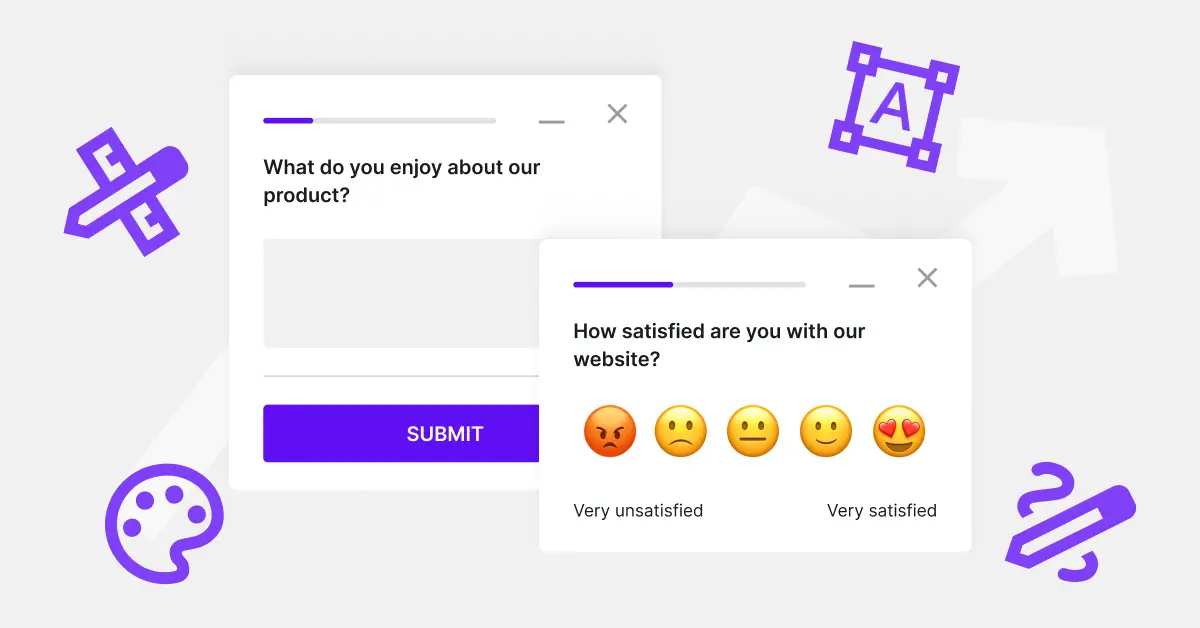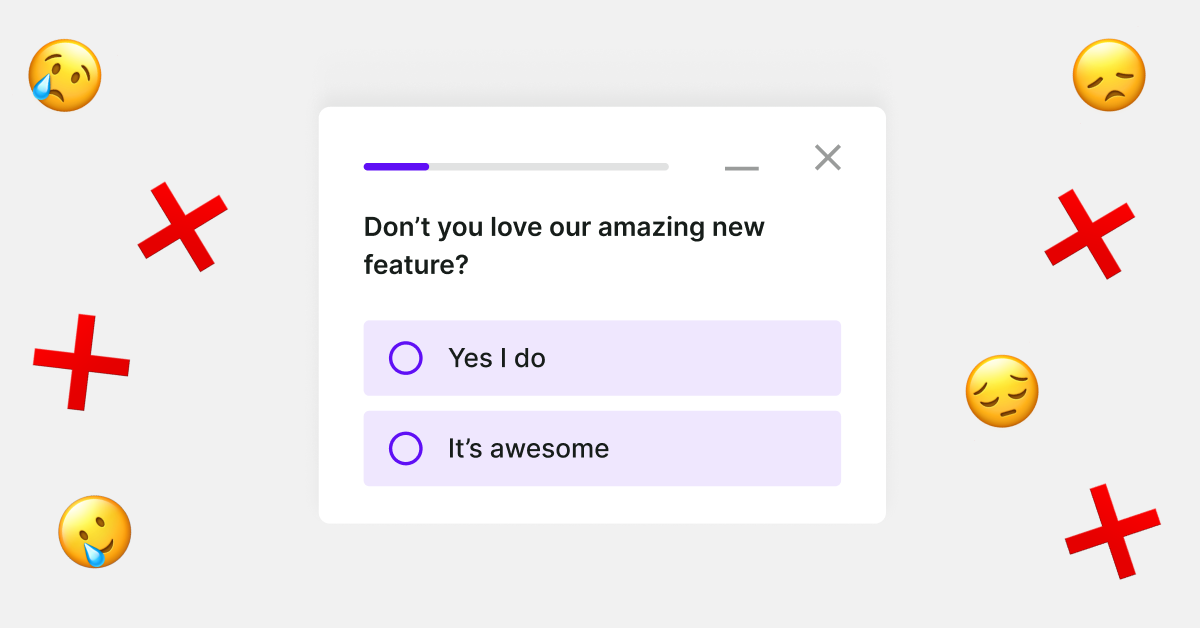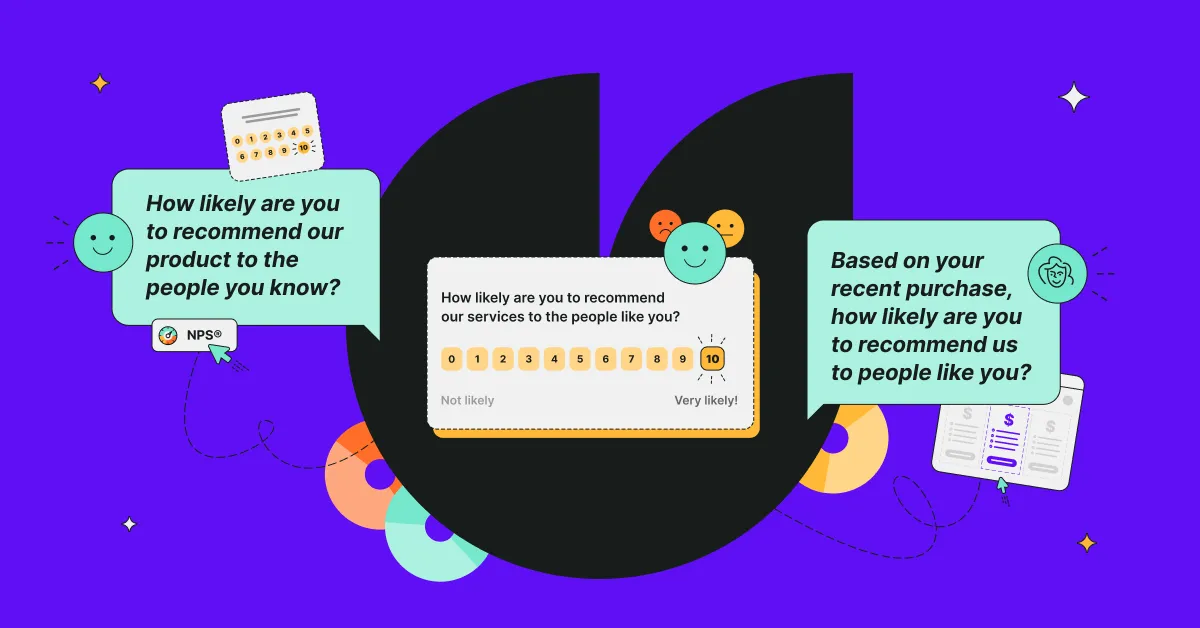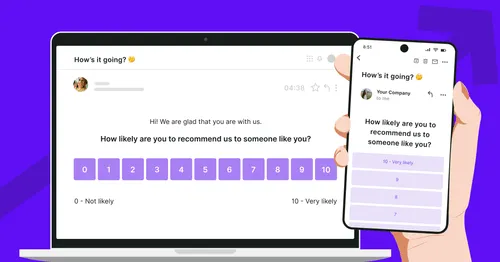Tl; dr;
- Survey analysis simplified: Likert scale streamlines the customer feedback process, converting complex opinions into manageable data, which simplifies the analysis and helps in making informed decisions.
- Competitive analysis: Online surveys that use the Likert scale can be helpful for competitive positioning, providing clear benchmarks on customer experience and satisfaction against competitors.
- Psychometric scale selection matters: Choosing between 4-point to 10-point scales impacts the data's nuance and precision. The scale should align with the objective, capturing subtleties or forcing a clear-cut opinion.

Are you looking for the very best way to get the most out of your customer surveys?
If you want to know how to gain insight into your customers' behaviors and sentiments about your service or product, you need to know about Likert scale questions.
What is a Likert scale?
Likert scale is a rating scale developed by an American psychologist, Rensis Likert.
It helps discover precisely how your customers feel about your website customer experience, product or service satisfaction, and customer service experience.
The use of a Likert scale survey varies. The answer options range from one extreme to another on a predetermined scale. Typically, they are strongly agree, strongly disagree, and everything in between.
Check out this customer experience survey template to see how the Likert scale is used in practice:
The biggest advantage of a Likert scale survey is that it allows you to collect customer feedback without asking open-ended questions that are much more difficult to process. It makes it easy for respondents to leave feedback and for you to analyze the survey results and gauge customer satisfaction levels.
Differences between an odd and even Likert scale
The 5- or 7-point rating system is the most popular as it gives your customers a wide enough range of answers to choose from. It lets them communicate their sentiments effortlessly and accurately. (Having said that, shorter 3-point Likert scale surveys are also in use.)
The advantage of an odd number of responses is that there will always be a middle-ground (neutral) answer for the customer to select. It's advantageous as you make it possible for respondents not to have a stance, which may increase the response rate.
On the flip side, the neutral answers won't be very actionable.
An even number of answers is sometimes used to make customers form an opinion. You need to remember, though, that such even-numbered Likert scale questions may elicit responses that are not entirely reliable.
4-point Likert scale
- No neutral option: Forces a more decisive response, reducing the chance of fence-sitting.
- Clear dichotomy: Simplifies the choice for respondents, often resulting in more polarized feedback.
5-point Likert scale
- Balanced: Includes a neutral option, allowing respondents to express ambivalence.
- Popular choice: Strikes a balance between granularity and simplicity, making it a common choice for researchers.
6-point Likert scale
- Eliminates neutrality: Encourages a clearer lean towards positive or negative responses.
- Increased differentiation: Offers a wider range of options for respondents, which can capture subtler opinions.
7-point Likert scale
- High resolution: Provides a finer scale, which can be useful for detecting small differences in responses.
- Greater specificity: Allows for more nuanced responses, which can be beneficial when measuring complex sentiments.
10-point Likert scale
Extensive range: Offers a broad spectrum of options, which can be useful for detailed assessments.
Precision: The wider scale can lead to more precise data but may also increase the cognitive load on respondents.
Likert scales are a versatile method for measuring attitudes, providing a quantifiable means of capturing people's opinions. The choice of scale points can significantly influence the data collection type and subsequent analysis. It's important to select the scale that best fits the research objectives and the nature of the data being sought.

Types of Likert scale questions
Likert scale questions are a foundational element of survey research, offering a range of response options that allow participants to express their opinions with precision.
Understanding the different types of Likert scale responses is essential for crafting questions that yield actionable survey data. Below are the various categories of Likert scale questions designed to measure specific aspects such as agreement, importance, likelihood, and satisfaction.
Agreement questions
This type of Likert scale question asks respondents to express their level of agreement with a given statement. For example:
Choose the option that most closely identifies with how you feel about the following statement:
It was easy to find the products I needed on somewebsite.com:
Strongly agree – agree – slightly agree – not sure – slightly disagree – disagree – strongly disagree
The question above is a classical customer effort score (CES) survey question. If you need to measure the effort required to perform an action within your product or service, feel free to use the Customer Effort Score (CES) Survey template by Survicate:
Importance questions
These survey questions require respondents to rate the significance of different items:
Rank the points below on how important they are to you:
- Speed of Shipping: very important – important – neutral – unimportant – not at all important
- Price of Shipping: very important – important – neutral – unimportant – not at all important
Likelihood questions
Likelihood questions gauge the probability that respondents will engage in a particular behavior:
How likely are you to refer our service to a friend or family member?
- Very likely – likely – uncertain – unlikely – very unlikely
Satisfaction questions
Satisfaction questions measure a respondent's contentment with a service or product:
How satisfied with our service have you been thus far?
- Very/extremely satisfied – satisfied – somewhat satisfied – undecided – somewhat dissatisfied – unsatisfied – very/extremely dissatisfied
To find more customer satisfaction questions, check the Customer Satisfaction Survey Template below:
Importance of Likert scales
Likert scales are critical tools for businesses to gauge customer sentiment feedback effectively. They offer a quantitative approach to understanding subjective attitudes, which can be helpful in strategic decision-making.
Measuring nuance: They capture the shades of opinion that binary questions might miss, allowing for a more nuanced analysis of responses.
Standardization: Likert scales provide a consistent method for data collection, ensuring comparability across different surveys and time periods.
Actionable insights: The data garnered from Likert scales can guide product development, feature prioritization, and customer experience improvements.
Employee engagement: For internal assessments, Likert scales can help in evaluating employee satisfaction and organizational climate, which are vital for maintaining a productive work environment.
Market research: In market research, they assist in understanding consumer preferences and brand perception, which are essential for crafting targeted marketing strategies.
Employing Likert scales can transform abstract opinions into concrete data, facilitating a deeper understanding of your stakeholders. This, in turn, supports data-driven strategies that can lead to improved user experiences, enhanced product offerings, and, ultimately, a more successful business model.
When should you use the Likert scale?
The Likert scale is an essential instrument for capturing the complexity of human sentiment in various business contexts. It is particularly beneficial when insights beyond a simple yes or no are needed. Have a look at some Likert scale examples in practice:
Customer experience metrics
Net Promoter Score (NPS): Although traditionally a 0-10 scale, a Likert scale can help you understand why customers are likely to recommend a product or service.
Measuring customer satisfaction (CSAT): Employ a Likert scale to measure customer satisfaction at different touchpoints, asking customers to rate their experience on a scale from 'Very Unsatisfied' to 'Very Satisfied'.
Likert scale questionnaire for employee engagement
Job satisfaction surveys: Use Likert scales to quantify employees' satisfaction with their roles, work environment, and leadership.
Training effectiveness: After training sessions, assess their effectiveness by asking employees to rate aspects from 'Not Helpful' to 'Extremely Helpful'.
Product development
Feature assessment: While conducting product research before releasing new features, ask users to rate their importance or usefulness on a Likert scale to prioritize development efforts.
User Experience (UX) research: Measure the usability of a product by asking users to rate their experience from 'Very Difficult' to 'Very Easy'.
Marketing and brand analysis
Brand perception studies: Understand how consumers view your brand attributes by rating statements from 'Strongly Disagree' to 'Strongly Agree'.
Ad campaign impact: Evaluate the effectiveness of advertising campaigns by having consumers rate their agreement with statements about brand recognition and message clarity.
Academic and market research
Social research: In fields such as psychology or sociology, use Likert scales to assess attitudes towards social issues, policies, or public services.
Consumer preference studies: In market research, ask consumers to rate product attributes or brand values to guide marketing strategies.
Incorporating Likert scales into your surveys can provide a wealth of actionable data. By thoughtfully utilizing Likert scales, you can enhance your understanding of customer and employee experiences, refine products and services, and make informed decisions that drive success.
The benefits of using Likert scale questions
Likert scale questionnaires are a staple in survey design due to their reliability and ease of interpretation. They offer:
Deeper insights
The major advantage of Likert scale questions over other types of questions is that they allow people to tell you where they stand in that grey area. Respondents are given a whole selection of answers to choose from. This way, you can obtain valid answers without asking for too much effort.
Improved response rates
By using Likert scale questions, you increase the survey response rate. The familiar format encourages participation, as respondents find it easy to express their views on a spectrum.
The straightforward nature of Likert questions helps to reduce survey fatigue, leading to more complete and thoughtful responses.
Enhanced data quality
Likert scales capture a range of responses, providing more detailed survey data than binary yes/no questions. They can also detect subtle variations in respondent attitudes and opinions.
Analytical advantages
Likert scale questions allow people to express their individual opinions without allowing them free rein with a text box.
It's much easier to analyze Likert scale data than the one coming from open-ended questions. The latter are ultra useful when designing new products or services or looking for marketing insights. But, to analyze them quickly, you need survey tools with filtering options.
- Quantifiable Opinions: Transform subjective opinions into quantitative data that can be statistically analyzed.
- Comparability: Standardized responses allow for comparison across different groups or periods.
⭐️ TIP:
You can choose to analyze the data you gather from your Likert scale questions using a median/mode, which will often prove the most useful.
A bar or pie chart will be best if you need to use the data at a glance.
Use tools like Survicate to receive regularly automated survey reports to your email box.
Versatility
- Adaptable: Likert scales can be used for a wide range of topics, from customer satisfaction to employee engagement.
- Cross-cultural: They are effective in diverse cultural contexts and do not require complex language or concepts.
Decision-making support
- Actionable insights: The data from Likert scales can directly inform policy-making, product improvements, and customer service strategies.
- Trend analysis: Over time, Likert scale data can reveal trends and patterns that might not be immediately apparent.
Incorporating Likert scale questions in surveys is a powerful way to gain insights into your audience's perceptions and preferences. Whether for internal assessments or market research, they offer a balanced approach to collecting valuable information that can drive strategic decisions.
Neutral ground or force to side
Depending on the data you need from the question, you can control whether you provide your customer or user with a neutral answer or force them to pick a side.
An odd number of points or responses will let the respondents sit on the fence. On the other hand, an even number will force them to come down on one side of the fence or the other.
Depending on your goals, you can either go for data that isn't skewed or risk concrete feedback that allows for an error margin.
Feel free to draw more inspiration from our Survey Template library or sign up to Survicate to get the feel of the entire platform.
Limitations of Likert scales
While Likert scales offer simplicity and effectiveness, they come with certain limitations that you definitely should consider.
Interpretation challenges
Likert scales can sometimes lead to biases in data interpretation. For instance:
- Central tendency bias: Respondents may avoid extreme response options, leading to data clustering around the middle of the scale.
- Acquiescence bias: Some individuals may tend to agree with statements regardless of their content.
Scale construction issues
The way the Likert scale chart is constructed can introduce limitations in capturing respondent opinions accurately.
- Non-differentiation: Respondents may use the same part of the scale for all questions, which does not reflect true differences in opinion.
- Limited options: Fixed response options may not capture the full range of a respondent's feelings or opinions.
Analytical complexities
While Likert scales are easy to implement, they present certain challenges when it comes to data analysis.
- Ordinal nature: Likert scale data are ordinal, not interval, which can complicate the use of certain statistical analyses that assume equal distances between points.
- Over-simplification: Reducing complex opinions to a single point on a scale may oversimplify nuanced views.
Respondent factors
The behavior and characteristics of respondents can influence the reliability of Likert scale responses.
- Survey fatigue: Lengthy surveys with many Likert scale questions can lead to respondent fatigue, which can affect the quality of the collected data.
- Cultural differences: Interpretations of scale points can vary by culture, potentially skewing cross-cultural comparisons.
Data quality concerns
Certain factors can compromise the quality of data obtained from Likert scales, affecting the validity of survey results.
- Social desirability: Respondents may select options they believe are more socially acceptable than those that reflect their true feelings.
- Misinterpretation: Respondents may misunderstand the scale without clear instructions, leading to unreliable data.
Understanding these limitations is key to designing more effective surveys and interpreting Likert scale data accurately. It's crucial to consider these potential drawbacks when analyzing results and making decisions based on this type of survey data.

Design your surveys with Survicate
The Likert scale remains an invaluable resource for capturing the subtleties of customer sentiment in a structured and measurable way.
It offers a middle ground between the simplicity of binary questions and the complexity of open-ended ones, allowing for a detailed spectrum of responses. While mindful of its limitations, you can benefit from the insights provided by Likert scale surveys.
To effectively harness these insights, Survicate offers an intuitive platform that facilitates the creation of these surveys and provides advanced analytics to easily interpret the data.
With features like automated reports and an AI survey creator, Survicate empowers you to make data-driven decisions with confidence.
Take the first step towards unlocking valuable customer and employee insights—sign up to Survicate for free with a 10-day trial that includes all the features of the Business Plan.

.avif)











.svg)

.svg)



